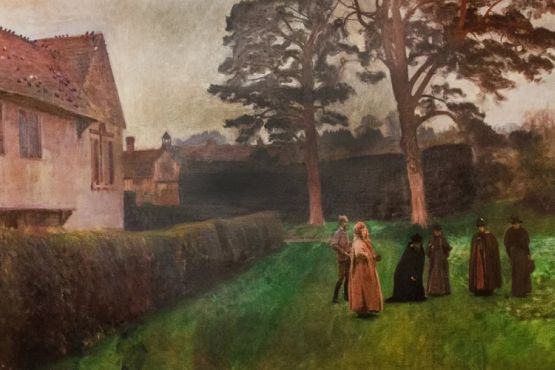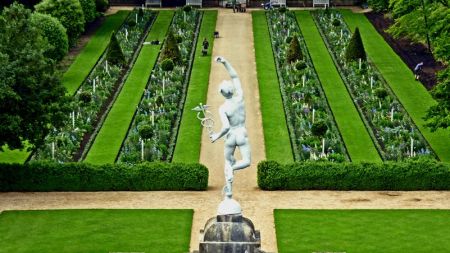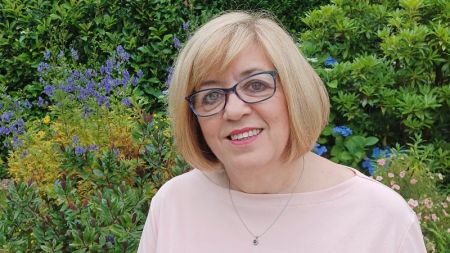How we’re bringing art back home with an ever expanding collection

We’re committed to developing the collections in our care and acquiring items that have strong connections with the places we care for, so they can be enjoyed by current and future generations for many years to come. We benefit from gifts, bequests, and occasionally purchase items – often with the support of generous donors and funders. The National Trust is also a major beneficiary of the Acceptance in Lieu Scheme, which allocates items to national bodies which have been accepted by HM Government in lieu of tax. As a result, joining our team means you’ll have the opportunity to care for – and share, with visitors – artworks and items created by some of the most revered artists, craftspeople, and historical figures. Read on below to discover more about a few of the latest additions to the ever-expanding collection of artworks we look after.
Cathedral Interior, 1621, Hendrick van Steenwyck, the Younger, oil on copper, Ham House, Surrey / NT 1140914
Acquired in 2020 for Ham House, in Surrey, this oil on copper perspective of Antwerp Cathedral was painted by Anglo-Dutch artist Hendrick van Steenwyck (1604–49) more than 400 years ago. Cathedral Interior once hung Ham House’s Green Closet, but remained with a member of the historic family after Ham House was transferred to the National Trust in 1948. In April 2020, with generous support from both the Art Fund and a fund set up by the late Simon Sainsbury, the National Trust was able to purchase the work. As a result, National Trust colleagues and visitors can once again view the piece in its long-standing home within Ham House’s Green Closet.
Saint Agatha by Carlo Dolci (1616 – 1687), oil on canvas, c. 1665-70, Osterley Park and House, London / NT 2900293
A painting by Italian artist Carlo Dolci (1616-1687) of the early Christian martyr Saint Agatha has been acquired by the National Trust for Osterley Park and House in Middlesex thanks to a grant from Art Fund and other generous donations.
The painting is a dramatic depiction of Agatha of Sicily, a Christian martyr, who suffered dreadful torture at the hands of the Romans. It is an example of the work of the Baroque master Carlo Dolci, a leading figure of 17th-century Florentine art, whose passionate depictions of holy figures aimed to inspire reverence and empathy for the divine. It captures the miraculous moment when Saint Peter the Apostle appeared to Saint Agatha in a vision and healed her wounds.
The painting was purchased by Sir Robert Child (1674-1721) at the beginning of the 18th century and became one of the works in a great picture collection at Osterley. It was recorded in a 1782 inventory, however, it was later sold along with other family heirlooms in the 1930s.
‘Saint Agatha’ was purchased for £248,750 at the Christie’s Old Masters Evening Sale in London on 5 July 2018 thanks to a grant of £85,000 from Art Fund, support from private donors, Trust members and visitors to Osterley Park, and from a fund set up by the late Simon Sainsbury to support acquisitions for the historic houses of the National Trust.
The Breakfast Table by Sir George Clausen, RA (1852-1944), oil on canvas, 1891-2 / Standen NT 2900207
The Breakfast Table by Sir George Clausen, RA has been bequeathed to Standen by the artist's granddaughter.
The painting shows Clausen’s wife Agnes Mary and their two daughters Meg and Kitty. It was painted in the early 1890s when the artist was influenced by the French Impressionists, becoming preoccupied with the play of light and shade. In this domestic interior, morning sunlight falls over the table catching the glaze on the blue and white porcelain.
Clausen is primarily known for his figure and landscape paintings of scenes of rural life. Born in London, he was elected a Royal Academician in 1908.
The Breakfast Table can be seen at Standen near works by Clausen's fellow artist friends including William Nicholson, Stanhope Alexander Forbes and Henry Herbert La Thangue.
Categories
- Apprenticeships (52)
- Building Surveying (3)
- Business Services (1)
- Catering (1)
- Communications and Marketing (3)
- Conservation (9)
- Countryside (10)
- Curatorship (3)
- Diversity (1)
- Estate Management (4)
- Finance (2)
- Food and Beverage (6)
- Fundraising (8)
- Gardening (11)
- General Management (2)
- Governance (2)
- Heritage Building Crafts (4)
- Holidays (3)
- House and Collections (4)
- IT (8)
- Membership (1)
- People and Legal (3)
- Projects and Programmes (6)
- Retail (2)
- This is us (5)
- Visitor Experience (3)
- Volunteer and Community (3)
- Volunteering (1)
- Work Experience (1)
- Young People (12)

